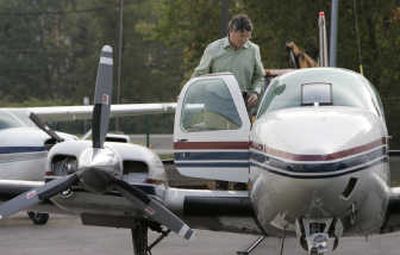Executives pilot their own course

NEW YORK – When a meeting with clients runs late, Andy Davidson doesn’t have to worry that his plane will leave without him.
Instead of impatiently waiting in mile-long security lines or silently waging war over a shared airplane armrest, Davidson can walk straight to his own six-seater, climb into the cockpit and take off.
Davidson, the owner of a New York-based financial consulting business, is a member of a small but growing group of businessmen who have taken their passion for flying and turned it into a more convenient – if less economical – form of transportation.
Most of these executives either buy or lease small planes, called single-engine pistons, with seating room equivalent to a family sedan and the ability to fly up to about 1,000 miles. With many airlines cutting back flights to smaller destinations, small business owners and midlevel executives are realizing that flying themselves might actually be feasible.
According to the Federal Administration Association, the number of hours single-engine piston planes are flown each year is expected to rise 17 percent by 2020, with growth of about 1 percent per year. Although some of that increase may be due to pilots who fly for recreation, FAA spokesman Hank Price said the government anticipates that business use of private aircraft will grow faster than leisure use.
Anecdotal evidence seems to confirm that more businessmen are seeing personal aviation as a transportation option. Flying clubs, where pilots can share ownership of a plane or receive additional training, are filling up with executives. One Atlanta-based club called Airshares Elite, founded in 1999, caters specifically to businessmen.
Airports have also started to recognize the importance of the businessman pilot. Clark County, Nev., recently spent $30 million remodeling Henderson Executive Airport, outside of Las Vegas, to appeal to executives.
Flying smaller planes – either by the executives themselves or the pilots they sometimes hire – has become so popular that it has begun to contribute to the nation’s air traffic and congestion.
But certainly, the benefits of private-plane travel are all too evident to anyone who’s ever been bumped from an overbooked flight or waited for takeoff at rush hour. Executive pilot Steven Hall, the managing director of his own executive compensation consulting firm, said he leaves his house only 30 to 40 minutes before he plans to take off rather than the two hours he budgets to go through security lines when taking a commercial flight. He said private planes, which leave from much smaller airports, are also not subject to the same delays in departures and arrivals as commercial flights using major airports.
“Most of us who travel on business can tell stories of sitting on the ground for four hours waiting for the plane to be cleared for takeoff for what was supposed to be a 90 minute flight,” Hall said.
Davidson agreed, saying that although the actual time in the air is about the same or possibly slightly longer in a private plane, flying yourself allows you to set your own schedule and makes for a much more relaxing trip.
“Any time I have to go on a commercial flight, it’s a depressing feeling,” Davidson said. “Between the check-in and the delays and the cattle-car feel of it, I think the whole experience has gone downhill.”
Davidson began flying after a friend took him on a small plane flight to East Hampton, N.Y.
“Until that moment it didn’t really occur to me that people could be pilots,” he said. “I thought only pilots could be pilots.”
Davidson got his license and after leaving Merrill Lynch & Co. in 1992 to start his own consulting group, he decided to buy a plane to visit clients. He upgraded to a larger six-seater Baron several years later and now uses it frequently for business.
“Just getting there becomes an enjoyable part of the travel,” he said.
Davidson does pay for that enjoyment. He estimated he spends about $50,000 a year on flying – including the cost of housing a plane in a hangar and maintaining it. That’s probably about $20,000 more than he would spend on commercial flights per year.
Phil Boyer, president of the Frederick, Md.-based Aircraft Owners and Pilots Association, said a new single-engine plane can cost about $400,000 to $1 million. Small used planes typically fall in the $50,000 to $60,000 range.
The process of getting a private pilot’s license also takes time. Boyer said the average is about six months, with 70 hours of flying time.
Hall earned his license in July. The East Islip, N.Y., executive bought a Cirrus SR22, a single-engine piston plane starting at about $370,000.
“I just took my time and plodded away and tried to learn how to land the thing,” said Hall, who estimated he’s flown about 50,000 miles so far and is thrilled with his investment.
For other businessmen, flying a plane can be even more of a necessity, noted Ed Bolen, president of the Washington D.C.-based National Business Aviation Association, which represents private aircraft users.
There are also cases where a plane has helped save a business.
Richard Shine, who owns Manitoba Corp., a metal recycling business outside of Buffalo, N.Y., credits his plane with just that. Starting in the 1970s, companies in upstate New York that once provided scrap metal to Manitoba started moving their businesses elsewhere. To expand the company’s supply base, Shine began using a small plane, in which he owned a half-interest, to find new suppliers.
Since then, the company has bought a bigger plane – a Mitsubishi Mu-2 Solitaire – and now makes the aircraft a major part of its marketing materials.
“We think of it as the same as having another sales person on staff,” said Shine, a former Air Force pilot. “It costs about the same, but it doesn’t complain, and it’s almost always willing to work.”